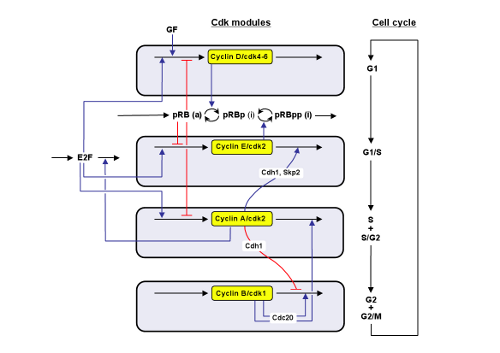Campus Plaine, CP 231, B-1050 Brussels, Belgium
We propose an integrated model for the network of cyclin-dependent kinases (Cdks) driving the mammalian cell cycle. The model contains four Cdk modules regulated by reversible phosphorylation, Cdk inhibitors, and cyclin synthesis or degradation. Growth factors trigger the transition from a quiescent, stable steady state to self-sustained oscillations in the Cdk network. These oscillations correspond to the repetitive, transient activation of cyclin D/Cdk4-6 in G1, cyclin E/Cdk2 at the G1/S transition, cyclin A/Cdk2 in S and at the S/G2 transition, and cyclin B/Cdk1 at the G2/M transition. The model accounts for major properties of the mammalian cell cycle, such as: (1) proliferation in the presence of supra-threshold amounts of growth factor; (2) antagonistic effects of the tumor suppressor pRB and the transcription factor E2F; (3) existence of a restriction point in G1; (4) endoreplication, i.e. repetitive cycles of DNA replication without mitosis. Incorporating the DNA replication checkpoint mediated by kinases ATR and Chk1 slows down the dynamics of the cell cycle without altering its oscillatory nature. The model for the mammalian cell cycle shows how the regulatory structure of the Cdk network results in its temporal self-organization in the form of sustained oscillations, leading to the repetitive, sequential activation of the four Cdk modules that brings about the orderly progression along cell cycle phases.
References:
Gérard C, Goldbeter A. 2009. Temporal self-organization of the cyclin/Cdk network driving the mammalian cell cycle. Proc. Natl. Acad. Sci. USA 106, 21643-21648.
Gérard C, Goldbeter A. 2011. A skeleton model for the network of cyclin-dependent kinases driving the mammalian cell cycle. Interface Focus 1, 24-35.
